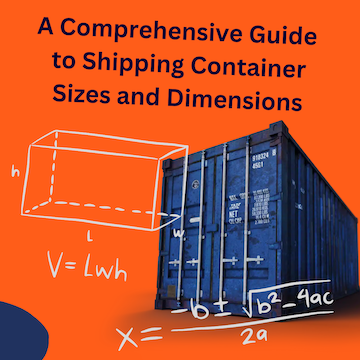Shipping containers have revolutionized the world of logistics and storage. These versatile and robust containers are used for various purposes, including shipping goods across continents, storing equipment on construction sites, and even as trendy mobile offices or homes. When it comes to choosing the right shipping container, understanding their sizes and dimensions is crucial. In this comprehensive guide, we will explore the different shipping container sizes available, their dimensions, and their common uses.

Standard Shipping Containers:
Standard shipping containers are the most common type and come in two main sizes:


20-foot Container:
The 20-foot shipping container is the industry standard and offers ample storage capacity. It measures approximately 20 feet in length, 8 feet in width, and 8.5 feet in height. These containers are suitable for small to medium-sized shipments and are often used for residential moves, as well as storing equipment and inventory.
40-foot Container:
The 40-foot shipping container is double the size of the standard 20-foot container. It measures around 40 feet in length, 8 feet in width, and 8.5 feet in height. These containers provide significantly more space and are commonly used for large shipments, commercial storage, and modified into offices or living spaces.
High Cube Shipping Containers:
High cube shipping containers are similar to standard containers but offer extra vertical space. They are ideal for transporting or storing goods that require more height. The two common sizes are:
20-foot High Cube Container:
The 20-foot high cube container has the same width and length as the standard 20-foot container. However, it provides an additional foot of height, measuring around 9.5 feet tall. These containers are advantageous for transporting tall items or creating additional vertical storage space.


40-foot High Cube Container:
The 40-foot high cube container offers the same additional foot of height as its 20-foot counterpart. With dimensions of approximately 40 feet in length, 8 feet in width, and 9.5 feet in height, these containers are excellent for oversized cargo, bulky machinery, or modified applications.
Specialized Shipping Containers:
Apart from standard and high cube containers, there are specialized containers designed for specific purposes. Some of the notable options include:
Reefer Containers:
Reefer containers, or refrigerated containers, are equipped with cooling systems. These containers maintain temperature-controlled environments, making them ideal for transporting perishable goods such as food, pharmaceuticals, or flowers.
Open Top Containers:
Open top containers feature a removable top, allowing for easy loading and unloading of goods from the top. They are commonly used for transporting heavy machinery or oversized cargo that cannot fit through the standard container doors.
Flat Rack Containers:
Flat rack containers are designed without sides, allowing for easy loading and unloading of heavy or oversized cargo from the sides. They are often used for shipping boats, vehicles, or large machinery.
Choosing the right shipping container size and dimensions is essential for successful transportation, storage, or modification projects. Whether you require standard containers for everyday shipping needs, high cube containers for extra vertical space, or specialized containers for unique requirements, understanding the available options is crucial. By considering factors such as cargo size, weight, and transportation mode, you can make informed decisions when selecting the perfect shipping container for your specific needs. At Storage Containers To Go, we offer a wide range of shipping containers to cater to diverse requirements, ensuring reliable and secure storage solutions for your goods.
ROYSE CITY WEATHER


